Content [show]
Cineraria (Cineraria) is a genus of plants belonging to the family Asteraceae or Asteraceae. Gardeners cultivate both various types of cineraria and species belonging to the closely related cineraria, the genus Senecio, the Tribe Rustic, which are members of the Asteraceae family. The genus Cineraria unites about 50 species that are found in nature, while according to various sources, there are 1-3 thousand species of the cineraria. Below we will talk about the types of cineraria and cineraria, which are most popular with gardeners.
In Latin, cineraria means "ashy". It is represented by shrubs and herbaceous plants. In the wild, such a flower can only be found in tropical regions of Africa and Madagascar. At home, only bloody cineraria (Cineraria cruenta) is grown, which is also called hybrid cineraria (Cineraria hybrida), but in fact this plant is a hybrid cross. In horticulture, this plant is cultivated as an annual or biennial. The height of the bush with strongly branching shoots is 30–90 centimeters. Large petiolate leaf plates are oval or lyre-shaped; in a larger number of species, they are pinnately dissected. There is pubescence on the surface of foliage and shoots. The terminal corymbose inflorescences include double or simple baskets with lingual flowers that have white, purple, red and yellow colors. They surround an islet of yellow tubular flowers. Flowering is observed from the second half of June until the first frost.
Growing cineraria from seeds
Sowing
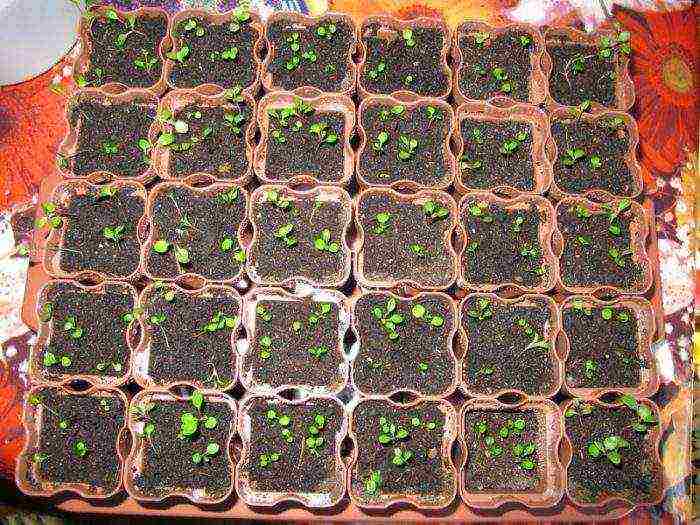
To grow cineraria from seeds, you first need to buy them. This can be done in a flower shop, since such a plant can be found relatively infrequently in gardens. The seeds are very germinating. It is recommended to sow seeds for seedlings in the first days of April. To do this, the container must be filled with peat mixed with sand (1: 1). Sowing is carried out on the surface of the substrate, the seeds are not buried. After sowing, you need to take a ruler from a tree and tamp the surface of the substrate. After that, the seedlings must be watered with a sprayer or using the lower method.Cover the top of the container with transparent glass.
Seedling
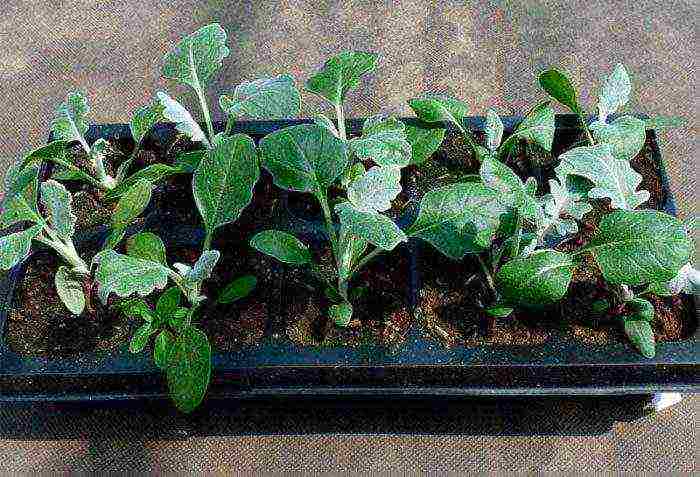
The first seedlings usually appear after 1–1.5 weeks. After that, the container must be moved to a place with good lighting. A pick into individual pots is carried out after 2 true leaves are formed in the plants. During the pick, the plant must be carefully removed along with the earthen lump. It is recommended to use peat briquettes as a container; as a result, there will be several times less problems during planting in open soil. With proper care of the seedlings in the garden, you will transplant powerful young plants.
Planting cineraria in open ground
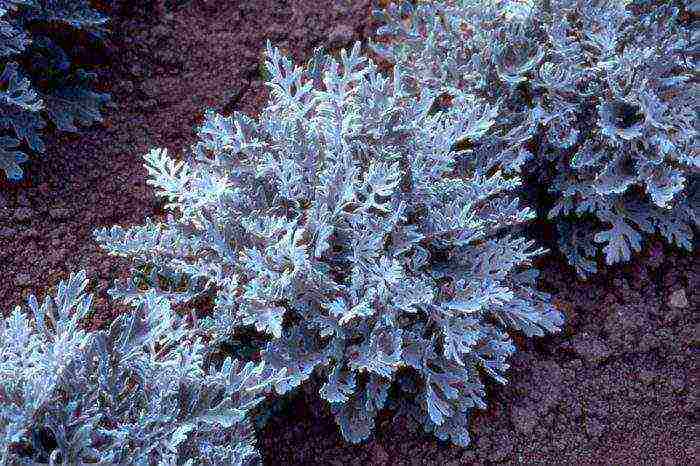
What time to plant
It is not very difficult to cultivate such a flower, especially if you know the basic rules for caring for it. It is recommended to choose a sunny area, but do not forget that such plants need shading at lunchtime. A well-drained soil, nutrient-rich, neutral or slightly alkaline, is suitable. Planting of grown seedlings can be carried out only after there is no threat of frost at night, as a rule, this falls on mid-May.
How to plant
Planting this plant in open ground is practically no different from planting other plants. The distance between the holes should be 20 to 25 centimeters. The disembarkation is carried out together with an earthen lump. When the cineraria is planted, compact the soil and water it. In the event that there is a danger of frost at night, then in the evening the plant should be covered with lutrasil or spunbond, and in the morning - removed.
Care features
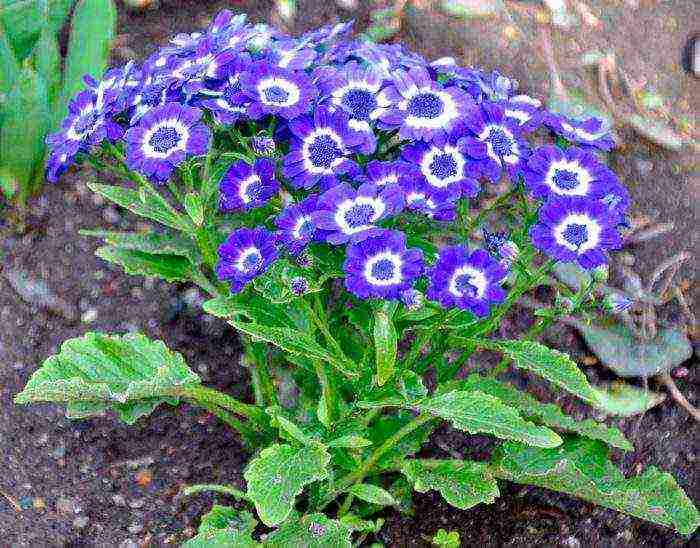
It is not difficult to care for this flower, but watering it correctly is very important. With an insufficient amount of water, cineraria becomes weakened, and if there is too much moisture, then rot begins to appear on the root system. It should be remembered that almost all species of this plant are resistant to drought and most often they have enough rain. After the plant is watered or rain has passed, the surface of the soil must be loosened, while removing the existing weeds. When the flowers begin to wither, they must be cut off, as a result of this cineraria will bloom much longer. Top dressing is carried out 2 or 3 times in 4 weeks and mineral fertilizer is used for this. Ornamental-flowering species need to be fed once every 7 days, using alternately mineral and organic fertilizers. If you have a decorative leafy look, then the buds in this case should be torn off as soon as they appear.
Reproduction of cineraria

How to grow a plant from seeds is described above, but only decorative flowering species can be propagated only in this way. Ornamental deciduous species can also be propagated by vegetative methods. Seaside cineraria (Cineraria maritima), for example, can be propagated by ten-centimeter cuttings in the summer. In this case, you will need a "cutter" (portable box), into which the cuttings will be planted. Such a device is necessary so that you can easily remove young plants (cuttings) from the midday direct rays of the sun. To make it, you will need boards and plywood. Don't forget to make drainage holes at the bottom. Then a ten-centimeter layer of garden soil mixed with sand is poured, on top - a layer of coarse-grained river sand (5-7 centimeters thick). The surface must be leveled and the substrate must be poured with a watering can with a solution of pink potassium manganese. Treat the cut of the cutting with the root root at the bottom, then immerse it in the substrate in the "cutting" and tamp the soil around it a little. After that, the cutting is covered with a cut plastic bottle, slightly sticking it into the sand. It will be possible to remove this shelter only after complete rooting.If necessary, watering the soil over the bottles should be carried out 2 times a day. Rooted plants need to start accustoming to the external environment, for this it is necessary to remove the bottles from them every day for 1-2 hours. After some time, the shelter must be removed for good and it is better to do this when it is cloudy or in the rain. For wintering, cuttings are placed in a cool room, without getting them out of the "cuttings". In spring, they are planted in open soil.
Diseases and pests
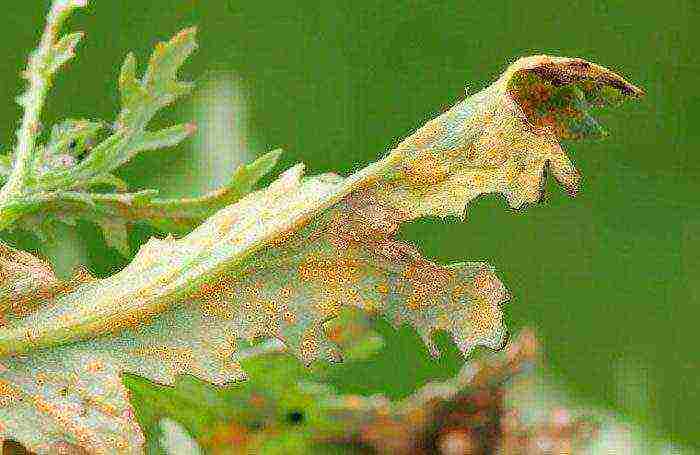
Decorative leafy cineraria is susceptible to infection with powdery mildew or rust (with high humidity and heat), and aphids and spider mites can also settle on it. Since these flowers have dense pubescence, it will be easier to prevent infection than to cure the disease. To exterminate pests, systemic insecticidal agents are used. But it should be remembered that all types of this plant are highly resistant to diseases and pests.
After flowering
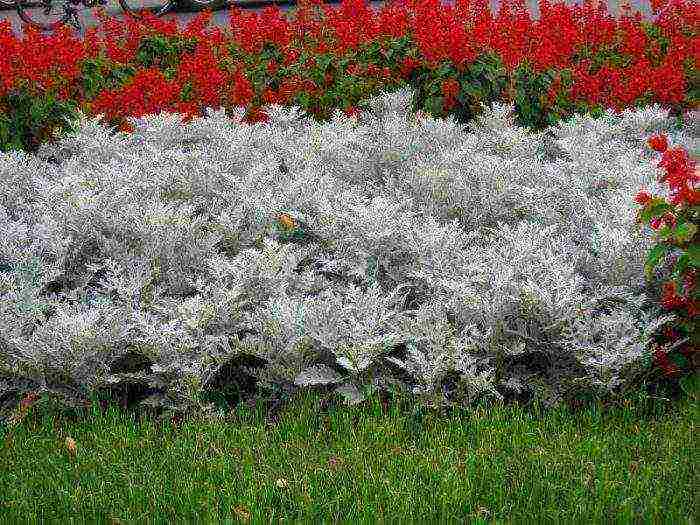
It has already been mentioned above that this very spectacular flowering plant in mid-latitudes is cultivated by gardeners as an annual. In this regard, after it has faded, it is simply destroyed. However, ornamental deciduous species are quite possible to preserve until next year. To do this, they must be prepared for wintering, namely, the bushes of the plant must be covered with a layer of dried leaves. In the spring, it is necessary to remove the foliage, and then cut off the parts that are frozen from the cineraria, as they can interfere with the growth of young shoots. There is also a second method that will help preserve this plant until spring. In the fall, it should be transplanted into a flower pot, and then transferred to a sufficiently lighted cool room. With the onset of next spring, you will only have to transplant this flower into open ground.
Main varieties and types with photos
All types of this plant, which are cultivated by gardeners and florists, are divided into 2 different groups. The first of them is decorative deciduous. Such cineraria are usually cultivated mostly in open soil. The second group is decorative flowering. Such plants are grown as indoor plants.
Cineraria maritima
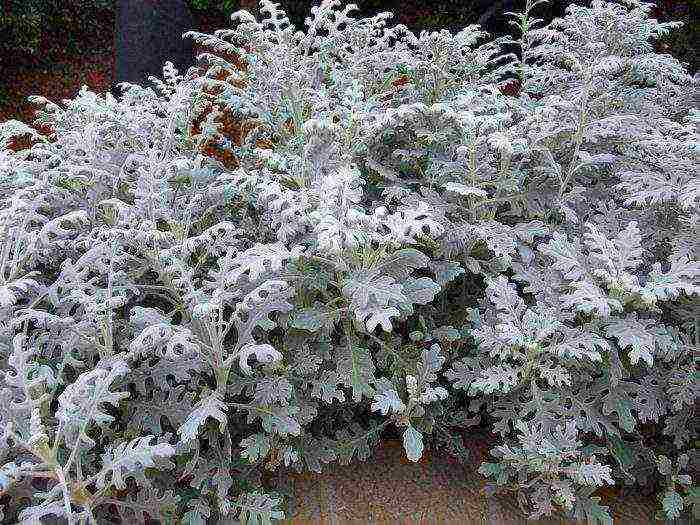
It is also called silver cineraria, silver cineraria or seaside cineraria. This ornamental deciduous plant is perennial. Its root leaf rosette includes leaf plates of an unusual greenish-silver color. This type is very popular in landscape design. The fact is that it is an excellent background for other greenery, as well as for plants with flowers of a very bright, saturated color. Also, this species can also be called "silver dust". The most popular varieties are:
- «Silver Dust"- such compact bushes have a small height and lacy leaf plates.
- «Cirrus"- such a bush has a greater height in comparison with the previous one, and on its lush bushes there are oval serrated leaves.
Cineraria hybrid (Cineraria hybrid)

Which is also called red cineraria, or bloody cineraria - such a bushy plant is decorative and flowering. The bush can be about 30 centimeters high or even more. Large, rounded leaf plates have a length of 10–20 centimeters. Against the background of lovely foliage, bright flowers stand out, which outwardly are similar to chamomiles or daisies. The most popular varieties are:
- Grandiflora - the bush has a height of 50 to 70 centimeters. The flowers are quite large and have a diameter of 5–8 centimeters.
- Double - bushes can be 35–70 centimeters high, flowers have a five centimeter diameter.
- Stellata - The bushes are very tall (70–90 centimeters), and the flowers are 2–4 centimeters in diameter.
- Sympathy - this plant is distinguished by the fact that its flowers can be painted in a variety of combinations of color shades.
Cineraria graceful (Senecio elegans)
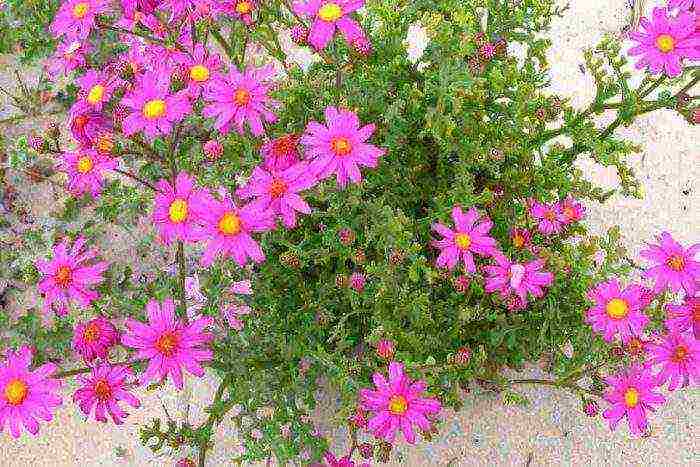
The height of the highly branched stem is about 60 centimeters, on its surface there is pubescence in the form of sticky hairs, as well as on the surface of the leaf plates. Flowers can be double or simple. They are part of the baskets, which are part of the corymbose inflorescences. Flowering lasts until the first frost. Popular varieties:
- Nanus - a bush of such a dwarf variety has a height of about 25 centimeters.
- Ligulosus - Terry flowers can be painted in a variety of colors.
Cineraria (lat.Cineraria) is a semi-shrub herb belonging to the Astrovye family. Translated from Latin, the name of the plant is translated as "ashy". Originally from the tropics of Madagascar and Africa. There are more than 1300 varieties of cynenaria: they differ in appearance and sometimes it is difficult to guess about their relationship. There are decorative leafy and decorative flowering varieties. These are one- or biennial plants with a height of 30-90 cm.
The stem is well branched, large leaves are attached on long petioles, the leaves are oval, lyre-shaped, most often pinnately dissected. Their color is silvery, in decorative flowering ones it is green. The leaves and stems are pubescent. Cynenaria flowers are similar to chamomile. Plain or double flowers are collected in corymbose inflorescences. Corolla color can be white, yellow, red, purple, blue. Flowering occurs in mid-June and lasts until late autumn (up to frost).
Growing cineraria from seeds
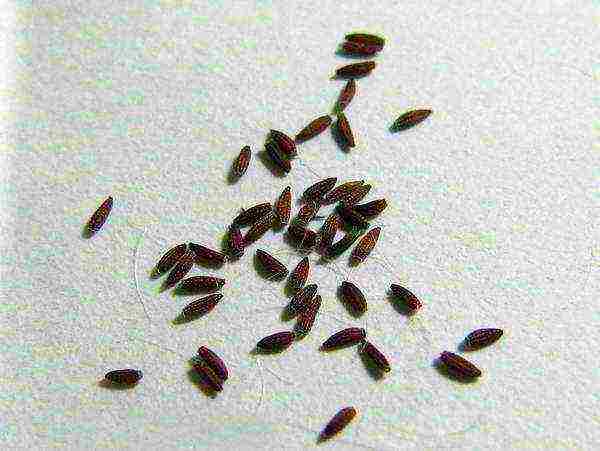
Cineraria seeds photo
When to plant cineraria seedlings?
It is necessary to grow seedlings for early flowering. Sow cineraria seeds in early March.
- Fill crates with an equal mix of peat and sand.
- Do not cover small cineraria seeds, but spread over the soil surface, compact with a wooden ruler, spray from a fine spray.
- Cover crops with foil or glass.
- Air the greenhouse, periodically spray crops.
- Seedlings will appear in 7-10 days.
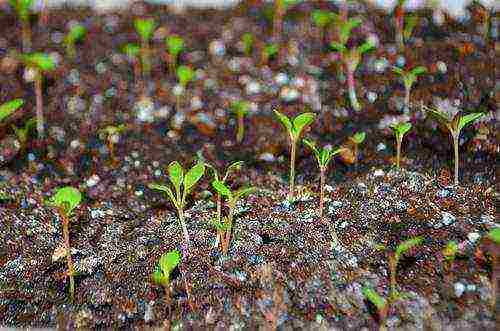
Cineraria from seeds photo shoots
- Provide delicate seedlings with bright, diffused lighting.
- With the appearance of 2 real leaves, dive and plant in peat pots.
- Further care consists in timely watering and maintaining bright diffused lighting, an air temperature of 20-22 ° C.
- When it gets warm, take the seedlings outside to harden. Plants accustomed to the sun and wind will painlessly transfer planting into the ground. Temper for at least a week.
Planting cineraria in the ground

Seedlings of cineraria seaside or silvery photo
- Plant in open ground from mid-May.
- Choose an area with bright lighting, but shade will be required at noon.
- The soil needs fertile, drained, neutral or slightly alkaline reaction.
- Dig holes in accordance with the size of the root system of the plant, keep a distance of 20-25 cm between plantings.
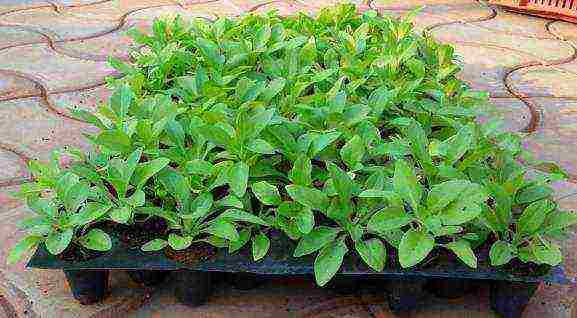
Seedlings of cineraria blooming ready for planting photo
- Transfer together with an earthen lump. Slightly compact the soil, water.
- If there is a threat of frost, cover with spunbond overnight.
Vegetative propagation of cynenaria
Decorative deciduous varieties are propagated vegetatively: by dividing the bush and cuttings.
Dividing the bush
- Divide the bush in the spring.
- Dig out a bush, each section should consist of a part of the rhizome and a ground shoot.
- Plant the cuttings in a permanent place of growth, water well for successful rooting.
How to propagate silver cineraria by cuttings
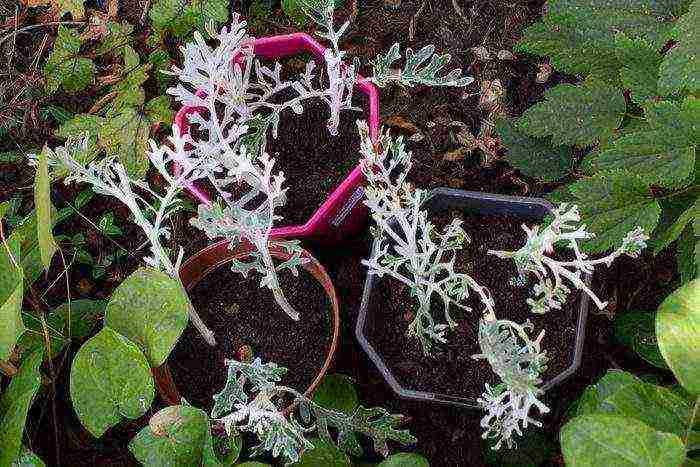
Reproduction of seaside cineraria by cuttings photo
In summer, propagate by cuttings.
Cut the cuttings 10 cm long, remove the bottom leaves. Use loose seedling soil. Pre-spill the soil with a slightly borous solution of potassium permanganate.Keep the cuttings in a solution of a growth stimulant for a day, stick them into the soil by 1.5-2 cm, compact the soil around the cuttings.
Cover with a cap from a cut plastic bottle, ventilate daily for 30 minutes. When new shoots begin to appear, gradually accustom to life without "shelter". Rooted cuttings should spend the winter in a cool room, and in the spring, transplant them into open ground.
Outdoor cineraria care
Balanced watering is necessary: an excess of moisture leads to decay of the root system, from a lack of moisture the plant weakens. But it is better not to water it again than to overmoisten the soil.
Loosen the soil, remove weeds.
Remove wilted inflorescences so that new ones will soon appear in their place.
In decorative leafy species, remove the buds as soon as they appear so that flowering does not take away strength and does not spoil the appearance.
Feed decorative leafy plants exclusively with mineral fertilizers, decorative flowering plants - with mineral fertilizers and organic matter. Apply top dressing every week.
Diseases and pests
Powdery mildew, rust are possible diseases of cynenaria. Remove the affected areas, treat with a fungicide.
Cynenaria can harm spider mites, aphids, whiteflies. It is necessary to carry out an insecticide treatment.
Preparing cineraria for winter
Most often, cynenaria does not tolerate wintering in the open ground and the bushes die, but you can try to save them by covering them with dry leaves and spruce branches for the winter.
You can dig it up, plant it in separate containers and leave it for the winter in a cool, bright room.
Types and varieties of cineraria with photos and names
Cineraria silvery or seaside Cineraria maritima

Cineraria seaside Сineraria maritima or silvery photo
Grown as an ornamental deciduous plant. The color of the leaves is silvery green.
Varieties:
- Silver Dust - undersized bush with lacy leaves;
- Cirrus is a sprawling bush, oval-shaped leaves with jagged edges.
Cineraria hybrid Cineraria hybrid aka red or bloody
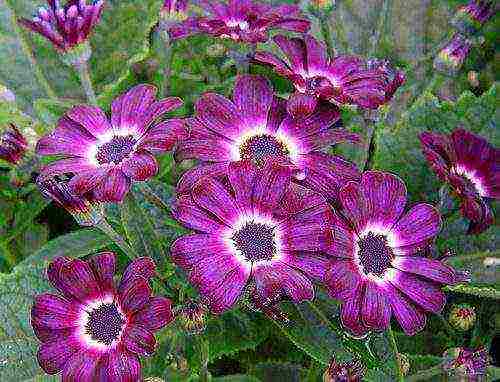
Cineraria hybrid Cineraria hybrid aka red or bloody photo
An ornamental flowering plant about 30 cm high.Round-shaped leaves are 10-20 cm long.
Varieties:
- Grandiflora - cynenaria 50-70 cm high, flower diameter is 5-8 cm;
- Double - a bush 35-70 cm high with a flower diameter of up to 5 cm;
- Stellata - reaches a height of 70-90 cm, the diameter of the flowers is 2-4 cm;
- Sympathy - flowers are distinguished by a varied combination of two shades.
Cineraria graceful Senecio elegans

Graceful groundwort or graceful cineraria Senecio elegans photo
Blooming view. The stem reaches a height of 60 cm, branches well. Inflorescences-baskets consist of simple or double flowers.
Varieties:
- Ligulosus - has double flowers;
- Nanus is a dwarf cynenaria about 25 cm high.
Cinenaria in landscape design
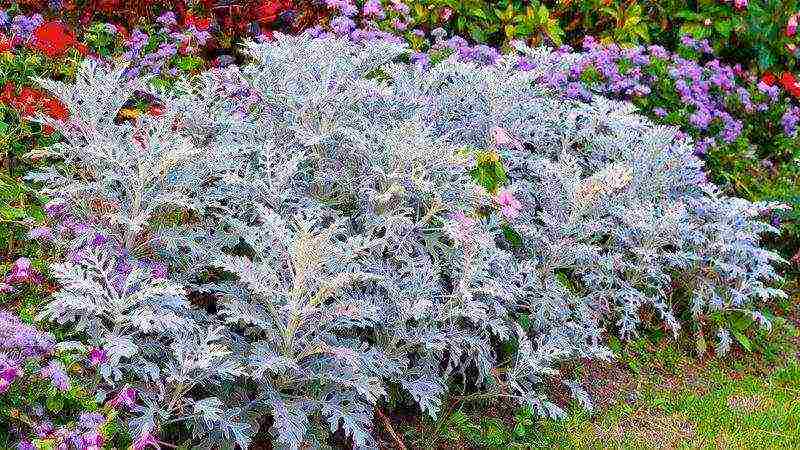
Cineraria silvery in mixborder photo
Decorative deciduous varieties look great in border plantings. They will be an excellent backdrop for lobelia, phlox, petunias.
Blooming cynenaria are good in group plantings in flower beds.
Content
- Species diversity
- Growing cineraria from seeds
- Landing in the ground
- Basic conditions for care
Cineraria is a real find for flower lovers. The variety of its decorative varieties gives its splendor to anyone garden or home, while delivering a minimum of care.
Cineraria is a very effective decorative flower
Despite some capriciousness, the cineraria flower is quite popular among fans of decorative flora. The variety of species allows each grower to choose a plant to their liking. For indoor cultivation, bright, abundantly flowering are used plants, for landscape design preference is given to deciduous species with a mass of unusual-looking leaves.Fully blossoming cineraria looks spectacular - the color of the petals is very saturated, the flowers make up a dense cap of a large area.
White cineraria flowers with contrasting tips look amazing
Species diversity
Among the annual ornamental plants, this genus is distinguished by a large number of species. However, we most often use only some of them with the most original appearance. But even in this small list there are plants that are completely different from each other.
- Perhaps the most decorative of all types for open ground is seaside cineraria. This native of the Mediterranean is ideal for decorating borders, as a background plant due to the original white and silver color of the feathery leaves, for which it is also called silver cineraria. Pubescent plates of complex shape create a beautiful carpet, against the background of which juicy greens and bright flowers of other inhabitants of flower beds, rabatok and lawns.
Bright flowers look very impressive on a silvery background of leaves
Cineraria seaside has original leaves of a white-silver color
The silvery color of seaside cineraria looks very harmonious against the background of bright greenery
Advice! To achieve the maximum decorative effect, the planting of silvery cineraria is made with a continuous tape. The spherical bushes form a beautiful roller that can be used to frame any flower arrangement.
- Colorful hats of small flowers in saturated colors are given by indoor cineraria, or bloody, originally from the Canary Islands. It can be grown in pots as well as outdoors. Inflorescences last for a very long time, giving the plant an elegant look. The color of petals in different varieties makes up a wide palette - from pink to purple and blue shades.
White petals with purple tips look simply irresistible
Lovely cineraria flowers of a pleasant blue color
Colorfully beautiful small flowers of room cineraria
Indoor cineraria has a huge number of amazing hybrid varieties.
Indoor cineraria with other flowers looks just great
- South Africa also gave flower growers its representative of this vast genus - graceful cineraria... This most unpretentious plant is only slightly inferior to its relatives in decorativeness, but the simplicity of its cultivation and very long flowering makes it popular with lovers of home and garden flora.
Cineraria graceful - a very unpretentious and beautiful plant
The contrast and variety of shades of cineraria never ceases to amaze
Growing cineraria from seeds
As practice shows, it is best to grow these plants through seedlings. It is almost impossible to create the necessary conditions on the garden bed. Only graceful Cineraria can be sown directly into open ground - its unpretentiousness to growth conditions allows the use of such agricultural technology. Young shoots are very delicate and must be protected as much as possible from weather troubles, so the easiest way is to grow these flowers using the seedling method.
Since the seeds of cineraria are very small, they do not need to be embedded in the soil when sowing. It is enough to lay them out on the surface of the moistened soil, tamp them slightly and cover the vessel with the sown seeds with film or glass. Possessing a fairly high germination rate, they will sprout in about 10-14 days.
A pick is made when the sprouts form 2 true sheets. The delicate root system does not tolerate damage quite well, therefore, it is necessary to transplant the seedlings with a lump of earth, which will preserve the roots and ensure rapid rooting in a new place.
Sowing cineraria for seedlings and transferring to a permanent habitat is carried out at different times, depending on its variety:
- seaside - sowing in March, disembarkation - at the end of May;
- room - sowing in December, disembarkation in 8-9 months;
- graceful - sowing in early April, disembarkation in mid-May.
Indoor cineraria grows as a very dense bush
There are two ways in which cineraria reproduces - from seeds and vegetatively. Cuttings are rooted in a greenhouse or under individual shelters, for which you can use plastic bottlescut to the desired height.
Terrific Twisted Petal Indoor Cineraria Hybrid
Landing in the ground
It is not surprising that among the favorites of flower growers in different directions, cineraria is one of the leading places - planting and caring for it does not require special skills. It is only necessary to create the necessary conditions, and the flower will thank you with the magnificence of its appearance.
Young growth of cineraria is very tender
The grown and hardened plants are planted in open ground when the threat of sudden cold snaps has passed. Seedlings of Cineraria, like adult plants, do not tolerate heat well, so you need to choose a place enough illuminated, but not falling under the direct rays of the midday sun. The most suitable for this are the east and west orientation of the directions.
Lovely purple cineraria lawn
A delightful flower bed of cineraria of different colors and shades
To make cineraria feel most comfortable at home, flowerpots need to be placed on windowsdarkened by the lungs curtains... In the initial stage of development, plants need regular watering. When the flower stalks are laid and during the subsequent flowering, the need for moisture decreases.
The lighting should be strong enough, but not stinging
Cineraria looks harmonious with other colors
Room cineraria will perfectly fit into the interior of your home
Basic conditions for care
- The soil - the soil for cineraria should be light and nutritious enough. Plants are quite unpretentious, so you can use a regular mixture for ornamental crops.
- Temperature - originating from the coastal southern regions, the flower does not like sharp temperature fluctuations. Optimal for him will be the average mode - about 20 degrees. In hot conditions, there is a noticeable reduction in the duration of flowering. The plant retains its flowers for the longest time at a temperature of 15-18 degrees.
- Air humidity - the unpretentiousness of these bushes is mainly expressed in good drought resistance. They easily tolerate low humidity, it is enough to water them in the aisles, doing without spraying and rubbing the leaves.
- Watering - the water is used warm and after a rather long settling. When watering, you need to make sure that the greens do not wet, as well as stagnation of water in the ground - this can cause disease and death of the plant.
In order for cineraria to retain its beauty longer, you need to create the conditions it needs
- Lighting - should be intense enough, but not stinging. Soft diffused light of the western and eastern slopes and windows is the best option.
- Feed - produced during the period of plant formation. The application of nitrogenous fertilizers can be done one-time before the beginning of budding; at a later date, the plant is not very demanding on the nutritional value of the soil.
- Pruning - to prolong flowering, you need to remove dried peduncles, and in silver cineraria, get rid of them even before flowering, since its flowers are inconspicuous and only spoil the decorative appearance of plants.
- Diseases - most of all, plants of this genus are susceptible to various types of rot, which occurs when the moisture regime is violated. In addition, they can be affected by pests - aphids, spider mites, whitefly.
- Treatment - diseases of this kind of plants are easier to prevent than to cure. To combat powdery mildew and rust, antifungal drugs (fungicides) are used. The destruction of parasites is carried out using systemic insecticides.
Cineraria bouquets look very impressive
All these solutions are commercially available ready-made and packaged in bottles with spray guns, with which plants are sprayed. Since the planting of cineraria is carried out only for one season, it is enough to normalize the conditions of its maintenance in order to allow the plant to finish flowering and after that, simply remove it from the flower bed or from the flowerpot.
A wonderful bouquet of room cineraria
White cineraria looks very noble
Viola is a very beautiful and bright variety of cineraria
Choosing this bright, memorable plant for your garden or windowsill will help you achieve an excellent result - after all, its decorative properties fully deserve all the efforts that you put into growing and caring for flowers.
Cineraria - video
Cineraria - photo
Many of us, choosing a plant for
curb
, want it to be decorative, eye-catching, while well framing
track
or favorably emphasized bright
flower beds
... Cineraria is what you need!

Cineraria has many species that are very different from each other in appearance: herbaceous flowers and decorative dwarf shrubs. Cineraria flowers are very diverse in color, size and shape. And varieties of a silvery beauty - seaside cineraria are planted as an ornamental deciduous plant: its graceful silvery foliage looks great in borders and mixborders.
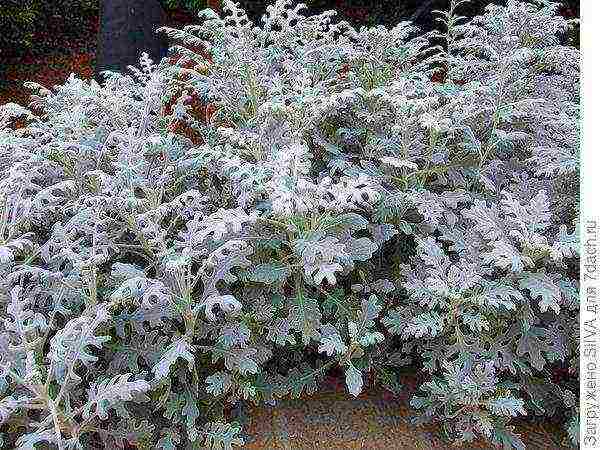
Cineraria belongs to the aster family. The genus of Cineraria is close to the genus Rustic, it includes some species common in amateur gardening (bloody cineraria, seaside cineraria, graceful cineraria). There are already about 1300 types of cineraria. In this article, we will look at the ones most often used in our gardens.
Since the types of cineraria are very different in their preferences, requirements and methods of reproduction, planting and care will be described separately for each.
Cineraria bloody, or bloody rosemary (Cineraria cruenta or Senecio cruentus)
Home to this species - the Canary Islands, it is an annual plant with oval light green leaves. This plant is often confused with a daisy due to the similarity of flowers. They, in turn, can be of a variety of delicate shades. Once I bought a potted cineraria in a flower shop, I really liked its pale pink flowers, but after flowering, the plant began to die.
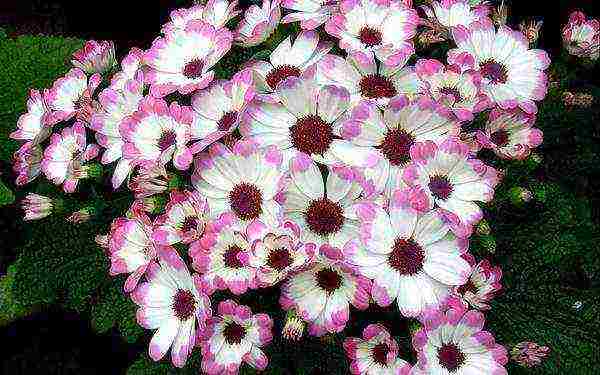
Planting and growing bloody cineraria
Bloody cineraria is often grown in pots, since it has a long growing season: flowers appear only 8-9 months after planting the seeds. However, bloody cineraria can also decorate a garden if you plant seedlings in winter and then transplant young plants into the ground. Cineraria loves warmth and humidity.
- Seeds for seedlings are planted December, they are very small, so they are not buried in the ground, but placed on moist, loose prepared soil from above, pressing down a little. It is better to cover them with glass before sprouting.
- Seeds are grown at temperatures from + 18 ... + 20 ° C, condensation must be removed from the glass.
- Seedlings appear after 2 weeks after planting.
- You can dive seedlings when the plant has the first two leaves. After that, the temperature of the seedlings is lowered to + 15 ° C so that flower buds are formed.
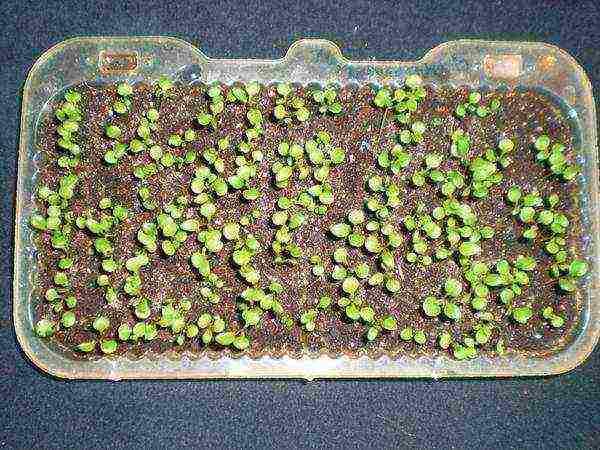
Late spring plants are transplanted into the ground. This type of cineraria is picky about soil moisture, so it is necessary to drain the soil well before planting. It should grow in a lit place, but so that the sun does not fall in direct scorching rays. Flowering suffers from lack of sunlight. Despite the love of moisture, it should not be poured, and stagnant water should be avoided, otherwise root rot will occur.
Bloody cineraria blooms by autumn. Flowering lasts a little over a month. The plant does not tolerate frost well, withstands temperatures up to -2 ° C.
Today there are many bloody cineraria hybrids, which are different in height, bush shape and color. For example, small flowers in the form of stars with a long stem from 70 cm bloom formsStellata.
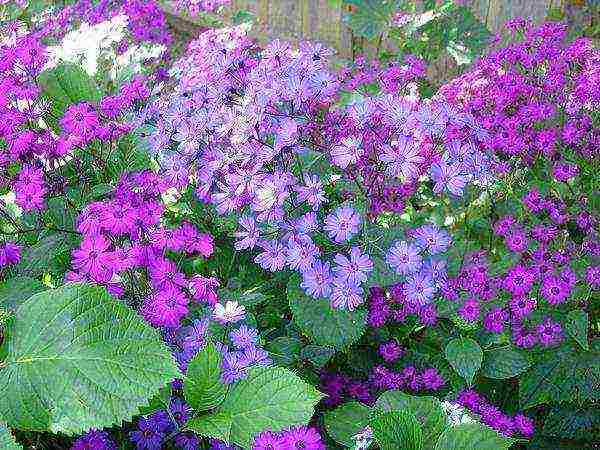
Dense small bushes with bright flowers bloom cineraria forms Nana.
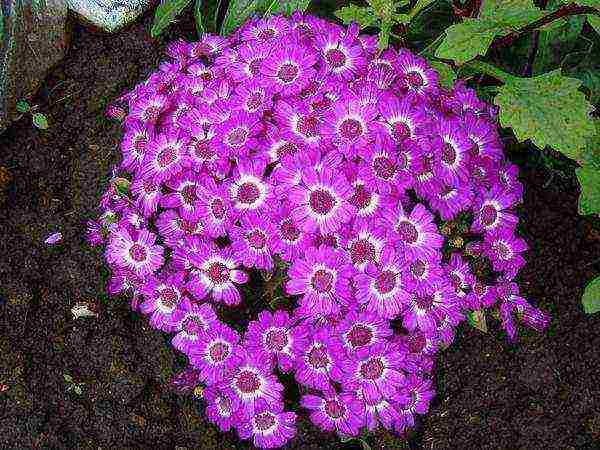
Large and bright inflorescences differ in shapeGrandiflorareaching 50 cm in height.
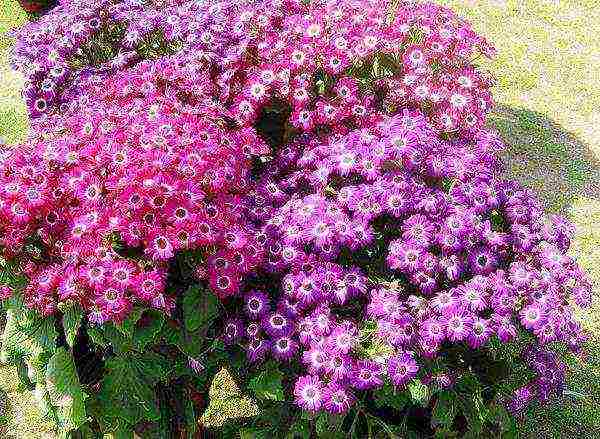
Seaside cineraria, or seaside cineraria (Сinerariа maritima)
I will not dissemble, this view is my favorite. It is good for a border, as an ornamental plant, framing plantings of bright flowers, and in outdoor vases and containers. He came to us from the Mediterranean. This species is considered a perennial, but it is customary for us to plant it as an annual plant.

The seaside cineraria is completely different from its cousin described above. The carved leaves are pubescent and silvery, thanks to which the plant is also romantically called “silver dust”. The inflorescences of this species consist of nondescript yellow flowers and are not at all decorative. Many gardeners simply remove them so as not to spoil the view.

Planting and growing seaside cineraria
The seaside cineraria grows much faster than its relative, bloody cineraria. Seeds for seedlings are planted in March, seedlings will appear in 10 days, after which they dive. It is necessary to feed the seedlings with mineral fertilizers. At the end of May, seedlings can be planted in the ground. The distance between the plants is about 15 cm.
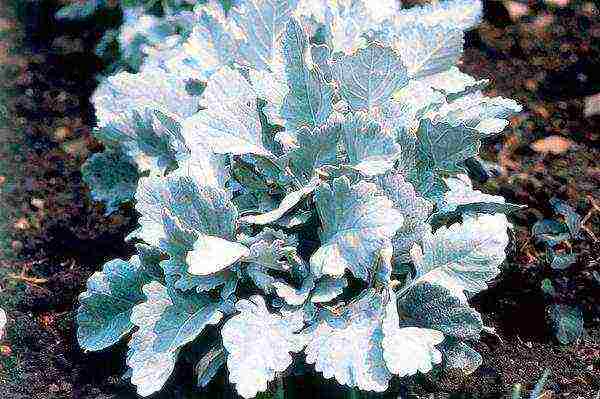
From personal experience I can say that no matter how much I tried to plant it directly into the ground under the film, I could not get the desired result. Therefore, I advise seedling method... Seaside cineraria also reproduces well by green cuttings.
This type of cineraria is not picky about the composition of the soil, but it still grows better on "crumbly" light soils, slightly acidic ones are also suitable. The sun is of great importance for this type of cineraria, because it is in the sun that the leaves are filled with a rich "white" color. Watering cineraria is required only at the beginning of growth, then the plant is completely not demanding on moisture.
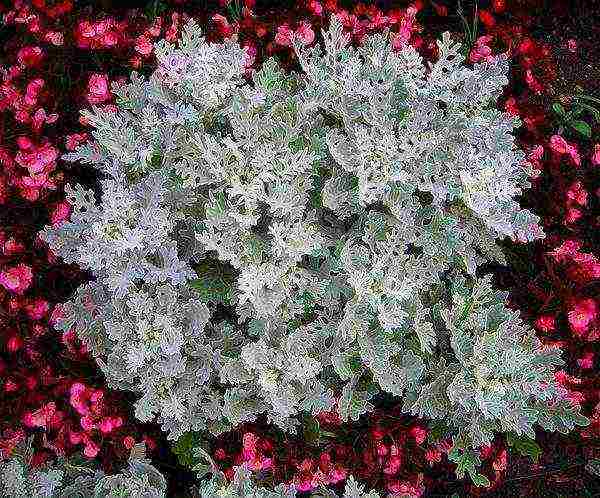
Popular varieties of seaside cinneraria
'Cirrus'. This variety is characterized by oval leaves with wavy edges, they are not carved, as in some varieties, but solid, green-silver in color. The older the plant, the more its color changes to a silvery white. Plant height of this variety is about 45 cm.
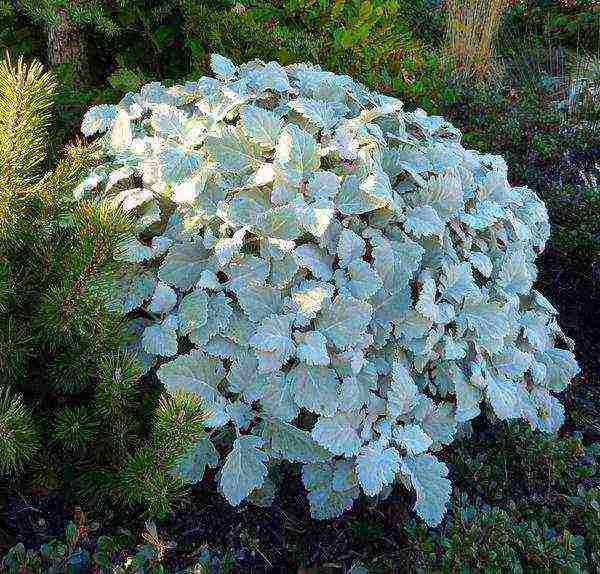
‘Silver Dust’. This variety belongs to the undersized. The height of its plants reaches about 25 cm, the leaves are carved, silvery-white.

Cineraria graceful, or graceful groundwort
This "wilder" sister of the cineraria described above has come down to us from South Africa. We grow it as an annual plant. In the rosette at the roots, the leaves are feathery dissected; sticky hairs are located on the leaves. Flowers in double or simple inflorescences, various shades. The tubular flowers in the center are yellow. From June until autumn, this species continues to bloom.
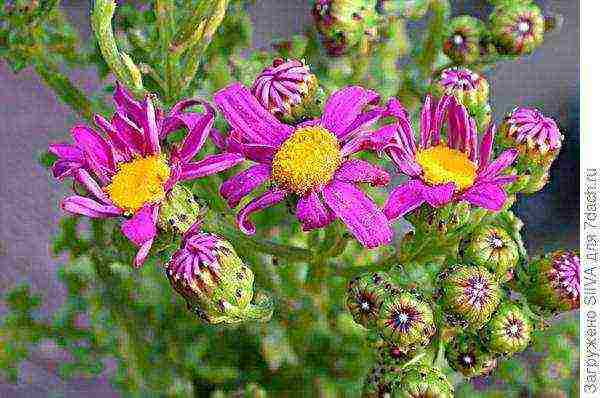
The graceful cineraria does not look as luxurious as its companions, but it is much more unpretentious.
Planting and growing cineraria graceful
The place must be sunny, soil rich in organic and mineral fertilizers, neutral or slightly alkaline. It is this species that can be sown directly into the soil as soon as the ground thaws and warms up a little, many gardeners do this. The distance between the plants should be about 15-20 cm. By the way, nothing grew in my time with such sowing. Therefore, in order not to think about seedlings, it is better to grow seedlings.
- Seeds for seedlings need to be sown in the beginning of April into boxes or directly into a greenhouse.
- When the seedlings have the first pair of leaves, they are dived into separate pots and the temperature is slightly lowered.
- In the middle of May the finished seedlings are planted in the ground.
In graceful cineraria, the faded heads must be removed in order to extend the period of its flowering.
So, if you really like the lush flowering bushes of bloody cineraria, you can try to grow it in the garden, but this is troublesome because of the long growing season, and you will have to repeat the procedure every year. The best choice for the garden - seaside cineraria, shading and emphasizing other flowers with its exquisite silvery foliage. There is evidence that even without insulation, this plant is able to winter and continue to please the eye for several years in a row. And the easiest to get in and out of them all - cineraria graceful, which can be successfully planted in flower beds and flower beds, combining with other plants.


